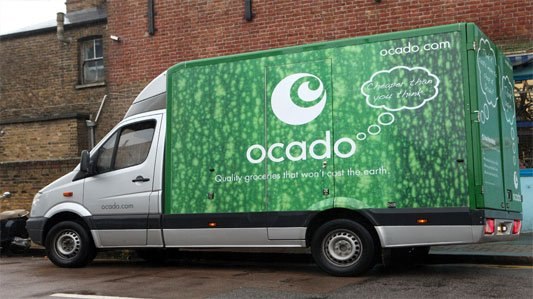Ocado is on the hunt for an agency as it prepares to advertise on TV for the first time. It wants to raise awareness as it fights for its place among both established supermarkets and emerging digital rivals.
But what is the objective of the campaign and who are Ocado trying to reach? Using YouGov Profiles, I have analysed the behaviours and attitudes of the groups the grocery retailer will be speaking to.
- Existing customers – people who have used Ocado in the past 12 months
- Those who know about Ocado but don’t currently use it (the “Awares”)
- People that are not aware of the retailer (the “Unawares”)
It seems logical that Ocado’s campaign is to raise a specific type of awareness (namely that online grocery shopping is easy) among those who can be tempted to give it a go. Our analysis shows that although there are certain differences between its current customers and “Aware” consumers, they do not seem to be insurmountable.
Reaching into this new territory through TV advertising would be more like expanding into adjacent field rather than invading a far-off island.
Underlying demographic make-up
Given Ocado’s campaign will focus on television, a good place to start is looking at how its current customer base matches up demographically against commercial TV viewers. On the whole, Ocado customers are for more likely than the commercial TV viewing public to be in the ABC1 social grades, married, female, have a large income, and live in London and the South East.
One hand, this provides a challenge to Ocado as it will have to reach out to people that are not its natural constituency. However, by the same token this also represents a huge opportunity – if it can use its adverts to speak effectively to a commercial TV audience, the rewards would be significant.
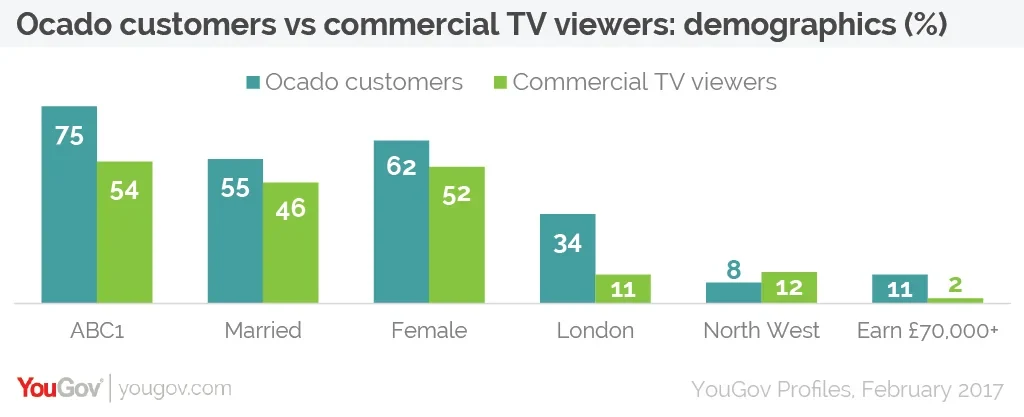
As grocery shoppers
The next thing to consider is how Ocado’s consumers stack up against non-customers across a variety of behaviours and attitudes. A significant challenge to the brand will be to alter the behaviours of people who currently like to shop in a particular way. While naturally the vast majority (70%) of Ocado’s customers regularly do online grocery shopping, the number plummets to 14% among Awares and 9% among Unawares.
Two reasons for this are that both types of non-customer are more likely to want to touch and feel products before getting them and they are also less keen to plan a weekly shop, something that may hinder online grocery purchasing.

As online shoppers
It stands to reason that Customers are the most likely group to believe that online shopping makes their lives easier. In addition to this they are also more likely than non-customers to shop online while watching TV (49% versus 37% for Awares and 28% for Unawares).
But there are heavy majorities across all of the groups who are comfortable with online shopping and think it makes their lives easier. To an extent, when it comes to promoting the benefits of online shopping Ocado is pushing at an open door when it comes to making its pitch to each of the three audiences.
However, it may be a marginally more straight forward when it comes to the Unawares (who search online for the products they see advertised while watching TV in similar proportions as the brand’s customers) as the figure is notably lower when it comes to the Awares (31%).
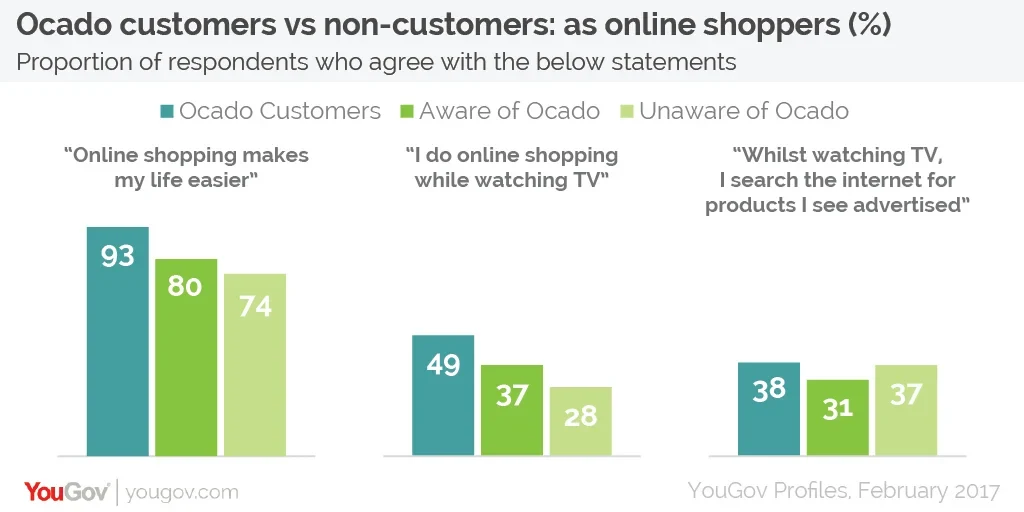
As viewers
When it comes to TV viewing, the three groups are quite different. Broadly speaking, Ocado’s customers watch live TV in relatively modest doses and are more likely to watch non-commercial to commercial channels (89% versus 75%). They favour late peak (8-11pm) to early peak (5:30 – 8pm) viewing.
By comparison, the “Awares” are generally heavier TV viewers who almost evenly split their viewing between commercial and non-commercial stations. While they too favour late peak viewing, given their greater appetite for television, they also watch early peak in great numbers, as well.
The “Unawares” are, relatively speaking, not as into TV. They generally watch fewer than 15 hours a week and are less likely than both “Awares” and Customers to watch commercial television. However, because they watch fewer hours of TV overall means they – like current customers – are less likely to be tuning in at either early or late peak times.
As viewers, the data points towards the Awares being the better bet for any TV advertising campaign.
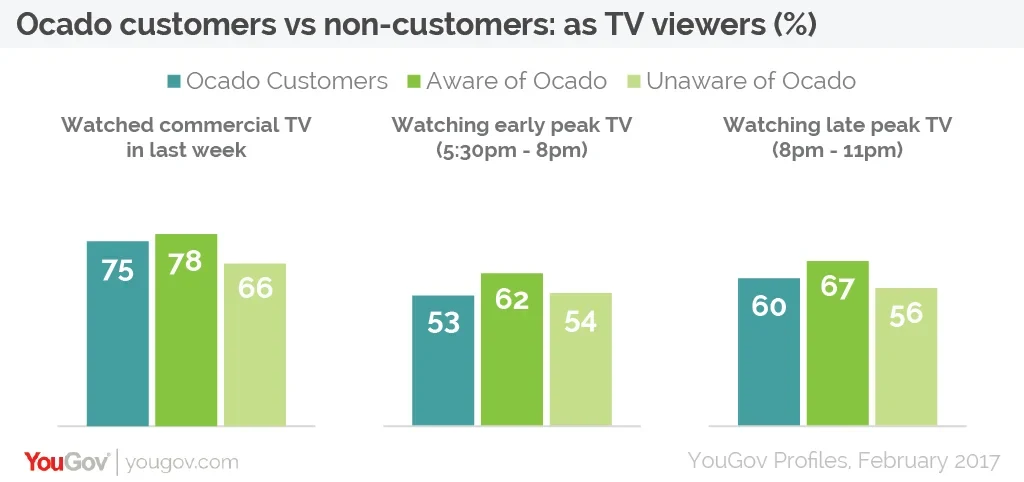
Differing attitudes
Finally, when it comes to the three groups’ attitudes, the “Awares” are more closely aligned with the brand’s current customers than the “Unawares” are. Across a range of areas – food, buying, the environment and even the media, those who are unfamiliar with the brand can be quite out of step with the other groups. Again, the data is pointing towards a campaign aimed at people who are already aware of (but not yet customers of) Ocado.
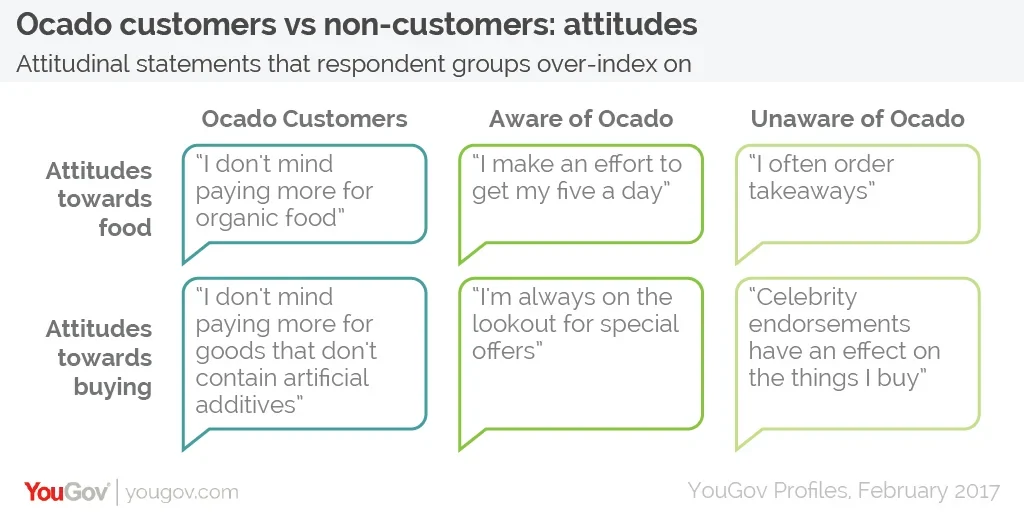
There are reasons what targeting either of the non-customer groups could be fruitful for Ocado and in certain aspects, such as a desire to touch products before they buy them, the Awares and Unawares are pretty similar.
And a campaign aimed at the Unawares may bear fruit. In a couple of areas – such as searching online for things they have just seen advertised on television and also the times they watch telly – the data suggests a TV campaign done in the right way could work for them.
However, the balance of data is notably more supportive of a campaign aimed at the Awares. Not only are they attitudinally better attuned to the brand’s existing customers, but they are also more similar as TV viewers and are also likelier to do things like plan their weekly shops. All of which makes them a safer bet as the target audience for the brand’s first TV campaign.
Image PA
